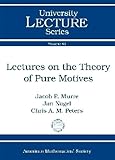Lectures on the theory of pure motives / Jacob P. Murre, Jan Nagel, Chris A. M. Peters.
Series: University lecture series ; volume 61Publisher: Providence, Rhode Island : American Mathematical Society, [2013]Copyright date: ©2013Description: ix, 149 pages ; 25 cmContent type:- text
- unmediated
- volume
- 9780821894347 (alk. paper)
- 082189434X (alk. paper)
| Item type | Current library | Home library | Collection | Call number | Materials specified | Copy number | Status | Date due | Barcode | |
|---|---|---|---|---|---|---|---|---|---|---|
| AM | PERPUSTAKAAN TUN SERI LANANG | PERPUSTAKAAN TUN SERI LANANG KOLEKSI AM-P. TUN SERI LANANG (ARAS 5) | - | QA564.M873 (Browse shelf(Opens below)) | 1 | Available | 00002143279 |
Includes bibliographical references (pages 139-144) 4and indexes.
1. Algebraic cycles and equivalence relations -- 2. Motives: construction and first properties -- 3. On Grothendieck's standard conjectures -- 4. Finite dimensionality of motives -- 5. Properties of finite dimensional motives -- 6. Chow-K✹neth decomposition in a special case -- 7. On the conjectural Bloch-Beilinson filtration -- 8. Relative Chow-K✹neth decomposition -- 9. Beyond pure motives.
The theory of motives was created by Grothendieck in the 1960s as he searched for a universal cohomology theory for algebraic varieties. The theory of pure motives is well established as far as the construction is concerned. Pure motives are expected to have a number of additional properties predicted by Grothendieck's standard conjectures, but these conjectures remain wide open. The theory for mixed motives is still incomplete. This book deals primarily with the theory of pure motives. The exposition begins with the fundamentals: Grothendieck's construction of the category of pure motives and examples. Next, the standard conjectures and the famous theorem of Jannsen on the category of the numerical motives are discussed. Following this, the important theory of finite dimensionality is covered. The concept of Chow-K✹neth decomposition is introduced, with discussion of the known results and the related conjectures, in particular the conjectures of Bloch-Beilinson type. We finish with a chapter on relative motives and a chapter giving a short introduction to Voevodsky's theory of mixed motives -- P. 4 of cover.
There are no comments on this title.

